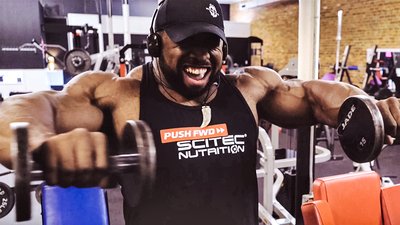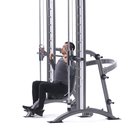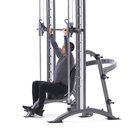At first glance, IFBB pro bodybuilder and 2017 Arnold Classic winner Cedric McMillan's four-move shoulder workout seems simple enough, but the devil is in the details.
In a word, his style is intuitive. Isometrics, slow negatives, partials—they're all in there. At one point, he transitions from a cable lateral raise to an upright row in the middle of a set. Later, he performs a mechanical dropset from rear delt raises to chest-supported rows. And that's just today.
"You catch me on any other shoulder day, and I can promise you it won't go the same way," he says. "Some people like to have structure. They like to have a set plan. Me, I like to train instinctively. I always say, when I go into the gym I don't like to have any distractions. Then it's like I can hear something whispering to me: 'Try this.' Or, 'Do that.' 'See how that feels.' 'Do another rep.' 'Hold it on that rep.' 'Do some slow negatives.'"
How the Champ Builds His Shoulders IFBB Pro Bodybuilder Cedric McMillan
Watch the video: 11:16
Don't expect clear sets and reps in the workout below. Everything is up in the air, and even McMillan himself couldn't tell you what he did once a set is done. This style of training is all about "how," not "how many."
This champ obviously knows exactly how to work each muscle effectively, and he's not afraid to try something new and different if it gives him a better result. To mimic his approach, focus on the muscles you are trying to work and pay attention to the little changes. They could add up to big results.

BodyFit
$6.99/month- 2,500+ expert-created single workouts
- 3,500+ how-to exercise videos
- Detailed workout instruction
- Step-by-step workout tips
- Training at gym or at home
- Access to Workout Plans
- Access to Bodyfit App
- Store Discounts
Already have a Bodybuilding.com account with BodyFit? Sign In

What comes with BodyFit?

- Instructional Videos
Don't risk doing a workout improperly! Avoid injury and keep your form in check with in-depth instructional videos.

- How-to Images
View our enormous library of workout photos and see exactly how each exercise should be done before you give it a shot.

- Step-by-Step Instructions
Quickly read through our step-by-step directions to ensure you're doing each workout correctly the first time, every time.
Note: Cedric doesn't count reps. Instead, he stretches and contracts on every rep and hits a range of intensities, ending the set when he's seriously fatigued. On presses, he likes to keep reps generally low, like 6-8 after a warm-up set. On isolation moves, he keeps reps high, such as in the 12-15 range.
Smith Machine Shoulder Press
Although his approaches may vary, McMillan always tries to begin his shoulder workout with some kind of press. In this workout, he uses a Smith machine for a front military press, pausing at the bottom of the warm-up set to deeply stretch the muscles and work them through their full range of motion.
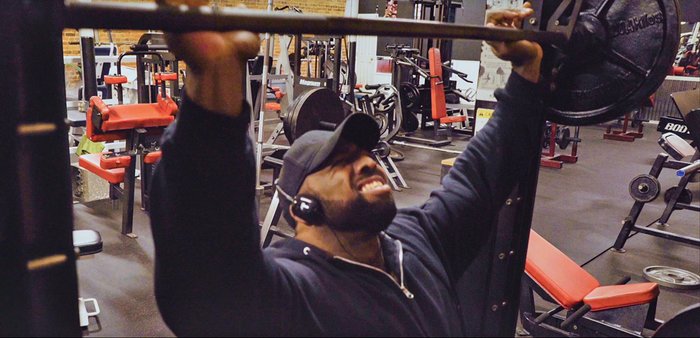
{{caption}}
"I believe a lot of times people get injured when the muscle is a little bit cold and they put a load on it, or have a lack of flexibility," explains McMillan. "A lot of people think you pull muscles because you lifted heavy weight, but if you have poor flexibility, that could get you injured just as easily."
Unconcerned with counting reps, McMillan chases what he considers the more valuable target: maximum effort.
"I never count on purpose," says McMillan. "Sometimes I will count just to make sure that I am progressing, but what I've found to be more productive is to put the weight on and just try to give maximum effort on each set."
McMillan explains that focusing solely on reps can be a hindrance—even a liability. If the target is 6 reps, for example, and you stop at 6, you might be limiting yourself. Or you might push yourself a little too hard trying to get 6 just because it's number you think you have to hit. By listening to the feedback from your muscles, you can lift with the same intensity McMillan does—emphasizing proper form and precise control.
Cable Lateral Raise
For the second shoulder exercise, McMillan prefers a side raise. As with the press, the approach may vary—machine, dumbbell, one arm or both—but today he goes traditional, with a single-arm, outward-leaning cable raise.
"I like to do it the old-school way where you lean away from the machine and extend your body out, because you get a little less gravity assistance," he explains.
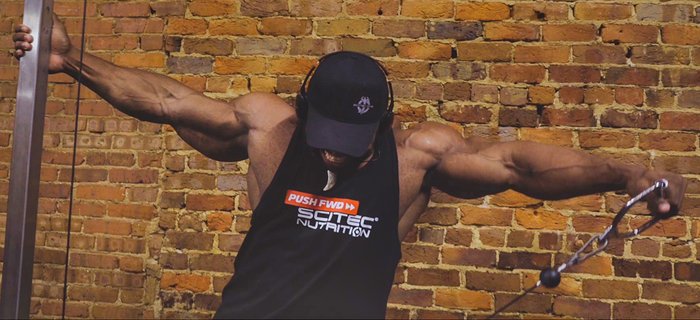
{{caption}}
By leaning away from the machine, you increase the range of motion and the time the muscles spend under tension, giving your shoulders a tremendous pump.
In the middle of the set, McMillan decides to switch to an upright-row version of the lateral raise, bringing up the elbow instead of just the hand.
"I tried it, and it felt really good before I started my set," he says.
He adds a set of this modified upright row to his workout, doing about 5 reps at a time and pausing the contraction on the fifth rep, for about 15 total reps.
Bent-Over Rear Delt Raise
McMillan says the bent over lateral raise is a challenging exercise, but not just because the rear delts are a tough muscle to work. Rather, he says, it's because he often feels it more in his lower back than his rear shoulders.
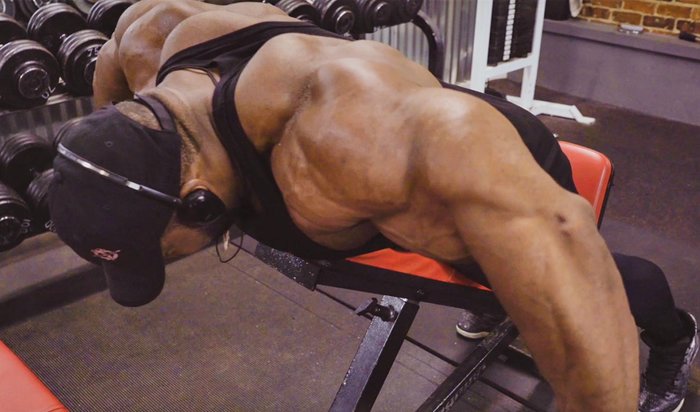
{{caption}}
McMillan solves this issue by positioning himself on an incline bench so his lower back doesn't have to hold him up. "By laying on this bench," he says "I'm not putting any tension on my back at all and am able to relax those back muscles so I can work nothing but the rear delts."
To really to lift like McMillan, start with a straight fly movement to failure, then move into an elbows-bent wide rowing motion for the second half of the set. As much as possible, try to limit tension in your traps throughout the work, as this larger muscle group can often take over rear delt work.
Forward Shoulder Press
Pay close attention—chances are this is not the shoulder press you were thinking of. For this exercise, raise both arms and keep them parallel to the floor as you press forward and back in the air without ever letting your arms drop. As McMillan jokes, this exercise rarely gets its due respect in the gym.
"If I see any of you doing this on Instagram, make sure you call it the right thing," he laughs.
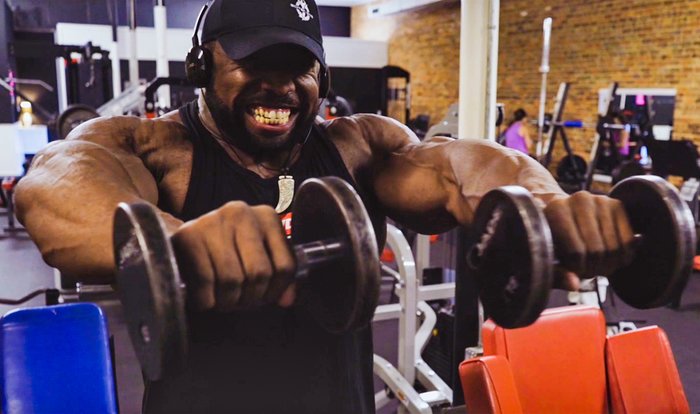
{{caption}}
You might do a double take at the sight of an IFBB pro straining under 15 pound dumbbells, but the constant tension provided by this gravity-defying movement is no laughing matter.
"I make sure the weight is moderate to light so I can control all of my repetitions," says McMillan. "There's no swinging the weight, no using momentum, nothing. It's just 100 percent control."
Once again, the name of the game is quality over quantity.
"I don't even count the reps on this," says McMillan. "I just take my time and make sure every rep looks good."
Stretching
As is often the case with elite bodybuilders, what elevates McMillan from the pack is not what he does with the iron, but what he does without it. Whether it's before his workout or after, morning or night, McMillan does an hour of stretching—yes, an hour—every day.
This practice began a few years ago when his massage therapist suggested his knee pain might be related to muscle tightness, and it's taken on a life of its own.
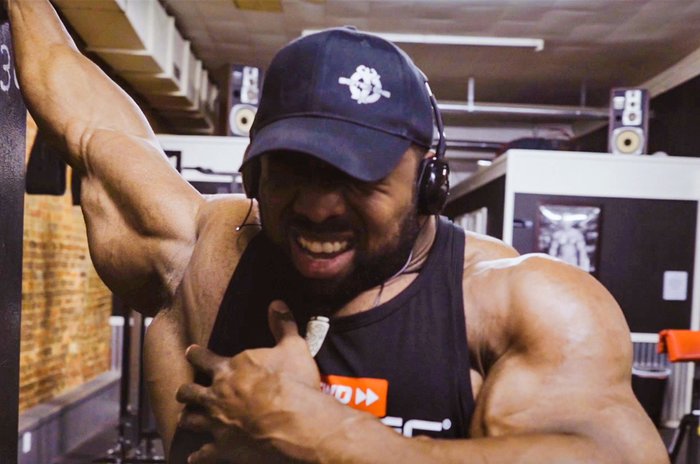
{{caption}}
"My stretching became like meditation for me," says McMillan. "Dealing with anxiety, you find different ways to manage the stress. I work on breathing, relaxing my mind, relaxing my body, taking in oxygen, and letting it circulate."
This level of control and focus distinguishes the good from the truly great. It may not be exactly your style, but McMillan's intuitive, focused approach offers deep insights into what it takes to become a champion.


